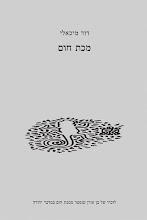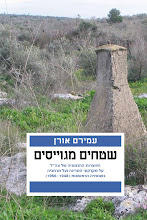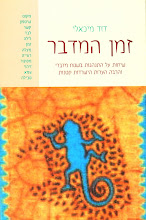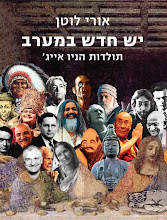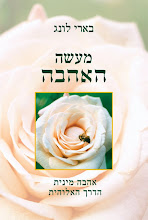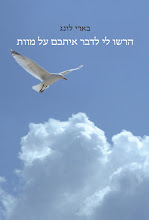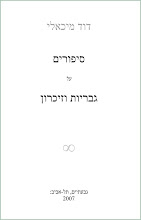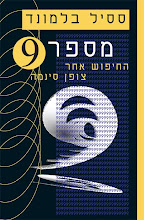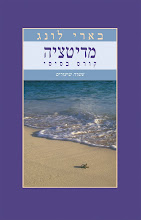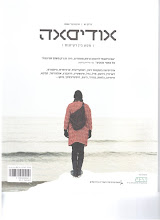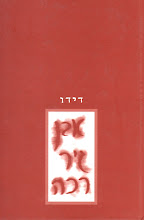יום שבת, 20 באפריל 2024
יום חמישי, 18 באפריל 2024
נראה כמו גשם / ג'והן פרי ברלאו / גרייטפולדד / עברית: דוד מיכאלי
נראה כמו גשם / ג'והן פרי ברלאו / גרייטפולדד
עברית: ד.מ. (תרגום משתי גרסאות אנגלית)
הַיּוֹם הִתְעוֹרַרְתִּי...
וְחַשְׁתִּי אֶת הַצַּד שֶׁלָּךְ בַּמִּטָּה;
הַשְּׂמִיכוֹת
הָיוּ עֲדַיִן חַמּות הֵיכָן שֶׁשָּׁכַבְתְּ.
הָלַכְתְּ, הָלַכְתְּ,
וְלִבִּי נִמְלָא אֵימָה;
אֶפְשָׁר
שֶׁלֹּא תִּישְׁנִי כָּאן עוֹד
אֲבָל הַכֹּל
בְּסֵדֶר, כִּי אֲנִי אוֹהֵב אוֹתָךְ, וְזֶה לֹא דָּבָר שֶׁיִּשְׁתַּנֶּה.
סוֹבְבִי
אוֹתִי וּפִגְעִי בִּי שׁוּב וָשׁוּב,
אֲבָל עֲדַיִן
אָשִׁיר לָךְ שִׁירֵי אַהֲבָה, כְּתוּבִים בָּאוֹתִיּוֹת שֶׁל שְׁמֵךְ.
וּבְאֹמֶץ
תָּבוֹא הַסְּעָרָה, וְזֶה מַמָּשׁ נִרְאָה כְּמוֹ גֶּשֶׁם.
הַאִם
הִתְעוֹרַרְתְּ פַּעַם אֶל הַצְּלִיל שֶׁל חֲתוּלֵי הָרְחוֹב שֶׁעוֹשִׂים אַהֲבָה?
אֶפְשָׁר
לְנַחֵשׁ מִצַּעֲקוֹתֵיהֶם כִּי הִנֵּךְ מַקְשִׁיבָה לַקְּרָב.
אַתְּ הֲרֵי
יוֹדַעַת, יוֹדַעַת, שִׂנְאָה זֶה מַמָּשׁ הַדָּבָר הָאַחֲרוֹן שֶׁהֵם חוֹשְׁבִים
עָלָיו.
אַתְּ
יוֹדַעַת שֶׁהֵם רַק מְנַסִּים לִצְלֹחַ אֶת הַלַּיְלָה.
אֲנִי רַק
רוֹצֶה לְהַחֲזִיק אוֹתָךְ, אֵינֶנִּי מִתְכַּוֵּן לִקְשֹׁר אוֹתָךְ
אוֹ לְהַכְנִיס
אוֹתָךְ לְמִסְגֶּרֶת, שֶׁאוּלַי צִיַּרְתִּי.
זֶה רַק
שֶׁאֲנִי, אֲנִי, הִתְרַגַּלְתִּי שֶׁאַתְּ כָּאן בַּסְּבִיבָה.
הַנּוֹף
שֶׁלִּי יִהְיֶה רֵיק, אִם תֵּלְכִי.
אֲבָל הַכֹּל
בְּסֵדֶר, כִּי אֲנִי אוֹהֵב אוֹתָךְ, וְזֶה לֹא דָּבָר שֶׁיִּשְׁתַּנֶּה.
סוֹבְבִי
אוֹתִי וּפִגְעִי בִּי שׁוּב וָשׁוּב
אֲבָל עֲדַיִן
אָשִׁיר לְךָ שִׁירֵי אַהֲבָה, כְּתוּבִים בָּאוֹתִיּוֹת שֶׁל שְׁמֵךְ.
וְגֶשֶׁם
עוֹמֵד לָבוֹא, הוֹ זֶה בָּטוּחַ נִרְאָה כְּמוֹ גֶּשֶׁם.
Looks
Like Rain
Words by John Perry
Barlow
I woke today...
And felt your side of bed
The covers were still warm where you'd been layin'.
You were gone...
My heart was filled with dread.
You might not be sleepin' here again
[Chorus:]
It's alright, 'cause I love you.
And that's not gonna change.
Run me round, make me hurt again and again.
But I'll still sing you love songs
written in the letters of your name.
And brave the storm to come,
For it surely looks like rain.
Did you ever waken to the sound
Of street cats makin' love
And guess from their cries
You were listenin' to a fight?
Well, you know...
Hate's just the last thing they're thinkin' of.
They're only trying to make it through the night.
[Chorus:]
I only want to hold you.
I don't want to tie you down.
Or fence you in the lines
I might have drawn.
It's just that I've gotten used to
Havin' you around.
My landscape would be empty
If you were gone.
Looks Like Rain
John Perry Barlow
Awoke today, felt your side of the bed;
The covers were still warm where you been layin'.
You were gone, oh gone, my heart was filled with dread;
You might not be sleeping here again.
But it's all right cause I love you, and that's not going to change.
Run me around and make me hurt again and again.
But I'll still sing you love songs, written in the letters of your name.
The rain is gonna come, oh it surely looks like rain
Did you ever waken to the sound of street cats
making love?
You guess from the cries you were listening to a fight.
Well you know, oh know, haste is the last thing they're thinking of.
You know they're only tryin' to make it thru the night.
I only want to hold you, I don't want to tie you
down
Or fit you in the lines I might've drawn.
It's just that I, oh I, have gotten used to havin' you around.
The landscape would be empty, if you were gone;
But it's all right cause I love you, and that's not going to change.
Run me around and make me hurt again and again.
But I'll still sing you love songs, written in the letter of your name.
The rain is gonna come, oh it surely looks like rain.
נטלי גוטמן / חיות בעלות נפש
David Michaeli / Snail
נטלי גוטמן
יום שלישי, 16 באפריל 2024
כֶּנֶגֶד אַרְבָּעָה בָּנִים | לֵאָה גוֹלְדְבֶּרְג
כנגד ארבעה בנים
אמר שאיננו יודע לשאול:
גם הפעם, אבי, גם הפעם
את נפשי, שחזרה מעמקי השאול,
מלט מעברה וזעם.
כי קטנו המלים מהביע השאול,
כי למוות אין ניב שפתיים
ואני, שאינני יודע לשאול
כבד פה אנוכי שבעתיים.
כי צווייתי לנוד בדרכים ארוכות
לא חדווה, לא שלווה, לא מנוח.
כי צווייתי לראות ביסורי תינוקות,
על גוויות עוללים לפסוח.
כי היכו על עיניי מגלבי פרשים
וציווני עיניי לפקוח
זחלו אל לילי נחשים לוחשים
לא לנום, לא לחלום, לא לשכוח.
ואני לא ידעתי, הלי האשם
הבגדתי, המעלתי -
לא רשע אנוכי, לא חכם אף לא תם
ועל כן שאלות לא שאלתי.
ועל כן לא דרשתי נקם ושילם
ולא אח לי ולא מלאך לי
והגעתי אליך בודד ושלם
ואתה, אם תוכל, פתח לי.
*
אמר הרשע: אבי, אבי,
אינני חפץ לרחם,
כי יבשה דמעתי, ויקשה לבבי
בראותי מה עשו לכם.
בראותי את בתך הקטנה בדמה
מקמצת אגרוף פעוט
וריסיה נוגעים בעפר אדמה
ועינה משוועת: למות!
בראותי להקות של כלבים משוסים
בתינוק כחוש-בשר בן חמש;
בראותי הנסים מבתים הרוסים
אל השחור, אל הבור, אל האש.
ונדרתי להיות ערירי וחפשי,
אכזרי וצונן וזר
עד שבאו אלי מבקשי נפשי
ודיני, גם דיני נגזר.
אין מתום בנפשי, אין מתום בבשרי
השיגתני נקמת אדוני
והגעתי אליך בודד ונכרי
ואתה, הקהה את שיניי.
*
שבכל הלילות נדלקים כוכבים בשמיים
ותלויים הטללים על ענף כדמעות על ריסים.
שבכל הלילות נדלקים כוכבים בשמיים
ואנשי הערים מדליקים פנסים.
ושלווה עמוקה וברוכה אל עיניך ניבטת
בזיכרון הליבוב של חיוך ילדים ישנים.
שבכל הלילות דומיה, צפיה ורטט -
הלילה הזה כולו יגונים.
שבכל הלילות מול רקיע אפל וזחוח
מול ירח חולה הזיות ומול שביל החלב
מהלכים בגנים אפלים בין ביעות וניחוח
רפאים עגומים וגדולים של היום שחלף.
שבכל הלילות איזו יד זידונית מכוונת
את רוחי התמהה אל מירמת האורות הכבים.
שבכל הלילות ציפיה, דומיה ועננת -
הלילה הזה כולו כוכבים.
*
והאב על בריחים סגר הדלתות
ולא קם ולא פתחם -
ויכרע להביט אל עיניו המתות,
אל עיניו של הבן החכם.
יום שבת, 13 באפריל 2024
ענת שרייבר / סדרת עבודות The Concrete Truth / בטון וטכניקה מעורבת על נייר / 60 על 80 ס"מ
ענת שרייבר / סדרת עבודות The Concrete Truth / בטון וטכניקה מעורבת על נייר / 60 על 80 ס"מ
באמנות שלי היום, אני שואלת שאלות שעוסקות בגוף,
בחמלה ובמחיר הכאב הנפשי והפיזי של המין האנושי והחייתי... מעניינת אותי
התנועה של ההשתנות במרחב, על אף הזעם שיש לי על מה שקורה עכשיו, ההשתנות
והעשייה החיובית הם תקווה עבורי לעדינות וחמלה חובקת כל.
You are so ------ Ridiculous!
You are so ------ Ridiculous!
Grow up, you crazy bastards!
Stop this stupid war immediately!
Kill the Jews
Kill the Ukrainians
Kill the Taiwanese
Kill the Armenians
Kill the Kurds
Kill the poets
Kill the singers
Kill women who laugh
Kill those who want to love anyone of any sort
Kill those who wear glasses
Kill anyone who has no beard
Kill anyone who has a beard
Kill everyone who is a bit smaller than you
Kill anyone who thinks differently than you
Stop immediately!
What is your story with killing?
More money? In addition to what you already
have?
More oil? More cars? More toys?
More land? How much land do you need?
More gold? How much gold do you need?
More honors? More respect? What is this crazy
idea of honor? Respect? Honor?
More medals? What are these stupid decorations?
More drugs?
What else?
What’s all this whining and complaining?
Constantly crying it’s mine! It’s mine! It’s
mine!
Constantly power! Power! Power!
Does your mother know what you’re doing?
Does your mother know how you’re behaving?
Immediately, stop what you’re doing
Right now, right away!
Go home!
Go home!
Try to tell your mother what you’ve done and
what you’re doing
What is your story with women?
What is your business with God?
Has he told you to kill everyone who is
different from you?
Does that sound reasonable to you? Grown-up?
Khamenei, do you ever look at yourself, or too
afraid?
Putin, do you ever talk to yourself, or are you
scared?
Shi, do you ever think to yourself, or just
afraid?
Kim, do you ever think on your own, or just
scared?
All these ridiculous face masks
All the ridiculous soldiers who stamp their
feet and raise their hands
You are sitting on a pyramid of murderers that
has reached my street
Every murderer looks like you, does that make
sense to you?
Are you unable to let someone else live?
Are you incapable of letting someone else think differently?
Who are you? Where did you grow up? What are
you lacking? Who raised you?
If you have so much power, why don’t you help
other people?
What pains you?
What’s eating you?
Stop it immediately!
You are so ———-
Ridiculous!
Pathetic.
אתם כל כך מגוחכים!
תִּתְבַּגְּרוּ כְּבָר מַמְזֵרִים מְטֹרָפִים
תַּפְסִיקוּ מִיָּד אֶת הַמִּלְחָמָה
הַמְּטֻפֶּשֶׁת הַזֹּאת
לַהֲרֹג אֶת הַיְּהוּדִים
לַהֲרֹג אֶת הָאוּקְרָאִינִים
לַהֲרֹג אֶת הַטָייוָונִים
לַהֲרֹג אֶת הָאַרְמֵנִים
לַהֲרֹג אֶת הַכּוּרְדִּים
לַהֲרֹג אֶת הַמְּשׁוֹרְרִים
לַהֲרֹג אֶת הַזַּמָּרִים
לַהֲרֹג אֶת הַנָּשִׁים שֶׁצּוֹחֲקוֹת
לַהֲרֹג אֶת מִי שֶׁרוֹצֶה לֶאֱהֹב מִכָּל סוּג
לַהֲרֹג אֶת בַּעֲלֵי הַמִּשְׁקָפַיִם
לַהֲרֹג אֶת מִי שֶׁאֵין לוֹ זָקָן
לַהֲרֹג אֶת מִי שֶׁיֵּשׁ לוֹ זָקָן
לַהֲרֹג אֶת כָּל מִי שֶׁקְּצָת קָטָן מִכֶּם
לַהֲרֹג אֶת מִי שֶׁקְּצָת חוֹשֵׁב אַחֶרֶת
מִכֶּם
תַּפְסִיקוּ מִיָּד
מָה הַסִּפּוּר שֶׁלָּכֶם עִם לַהֲרֹג?
עוֹד כֶּסֶף? בְּנוֹסָף לָמָּה שֶׁיֵּשׁ לָכֶם?
עוֹד נֵפְט? עוֹד מְכוֹנִיּוֹת? עוֹד צַעֲצוּעִים?
עוֹד אֲדָמָה? כַּמָּה אֲדָמָה אַתֶּם צְרִיכִים?
עוֹד זָהָב? כַּמָּה זָהָב אַתֶּם צְרִיכִים ?
עוֹד כָּבוֹד? מָה הַסִּפּוּר הַמְּשֻׁגָּע
הַזֶּה שֶׁל כָּבוֹד? כָּבוֹד? כָּבוֹד?
עוֹד עִטּוּרִים? מָה זֶה הַקִּשּׁוּטִים
הַטִּפְּשִׁיִּים הָאֵלּוּ?
עוֹד סַמִּים?
עוֹד מָה? מָה הַבַּכְיָנוּת הַזֹּאת?
וְהָעֶלְבּוֹנוֹת
כָּל הַזְּמַן זֶה שֶׁלִּי! זֶה שֶׁלִּי! זֶה
שֶׁלִּי!
כָּל הַזְּמַן כּוֹחַ! כּוֹחַ! כּוֹחַ!
אִמָּא שֶׁלָּכֶם יוֹדַעַת מָה אַתֶּם עוֹשִׂים?
אִמָּא שֶׁלָּכֶם יוֹדַעַת אֵיךְ אַתֶּם
מִתְנַהֲגִים?
תַּפְסִיקוּ מִיָּד אֶת מָה שֶׁאַתֶּם עוֹשִׂים
עַכְשָׁו וּמִיָּד
לְכוּ הַבַּיְתָה!
לְכוּ הַבַּיְתָה!
נַסּוּ לְסַפֵּר לְאִמָּא שֶׁלָּכֶם מָה
עֲשִׂיתֶם וּמָה אַתֶּם עוֹשִׂים
מָה הַסִּפּוּר שֶׁלָּכֶם עִם נָשִׁים?
מָה הַסִּפּוּר שֶׁלָּכֶם עִם אֱלֹהִים?
הוּא אָמַר לָכֶם לִרְצֹחַ כָּל מִי שֶׁשּׁוֹנֶה
מִכֶּם?
זֶה נִשְׁמָע לָכֶם הֶגְיוֹנִי? בּוֹגֵר?
חָמִינָאִי אַתָּה מִסְתַּכֵּל עַל עַצְמְךָ
לִפְעָמִים אוֹ רַק פּוֹחֵד?
פּוּטִין אַתָּה מְדַבֵּר עִם עַצְמְךָ
לִפְעָמִים אוֹ רַק פּוֹחֵד?
שִׁי אַתָּה חוֹשֵׁב לְעַצְמְךָ לִפְעָמִים אוֹ רַק
פּוֹחֵד?
קִים אַתָּה חוֹשֵׁב לְבַד לִפְעָמִים אוֹ רַק
פּוֹחֵד?
כָּל הַמַּסֵּכוֹת הַמְּגֻחָכוֹת הָאֵלּוּ עַל
הַפָּנִים
כָּל הַחַיָּלִים הַמְּגֻחָכִים שֶׁדּוֹפְקִים
בָּרַגְלַיִם וּמְרִימִים יָדַיִם
אַתֶּם יוֹשְׁבִים עַל פִּירָמִידָה שֶׁל
רוֹצְחִים שֶׁמַּגִּיעָה עַד לָרְחוֹב שֶׁלִּי
כָּל רוֹצֵחַ נִרְאֶה כְּמוֹכֶם, זֶה נִרְאֶה
לָכֶם הֶגְיוֹנִי?
אַתֶּם לֹא מְסֻגָּלִים לָתֵת לְמִישֶׁהוּ אַחֵר לִחְיוֹת?
אַתֶּם לֹא מְסֻגָּלִים לָתֵת לְמִישֶׁהוּ אַחֵר
לַחֲשֹׁב אַחֶרֶת?
מִי אַתֶּם? אֵיפֹה גְּדַלְתֶּם? מָה חָסֵר
לָכֶם? מִי גִּדֵּל אֶתְכֶם?
אִם יֵשׁ לָכֶם כָּל כָּךְ הַרְבֵּה כּוֹחַ
לָמָּה אַתֶּם לֹא עוֹזְרִים לַאֲנָשִׁים אֲחֵרִים?
מָה כּוֹאֵב לָכֶם?
מָה אוֹכֵל אֶתְכֶם?
תַּפְסִיקוּ מִיָּד!
אַתֶּם כָּל כָּךְ
------
מְגֻחָכִים!
פָּתֵטִי.















